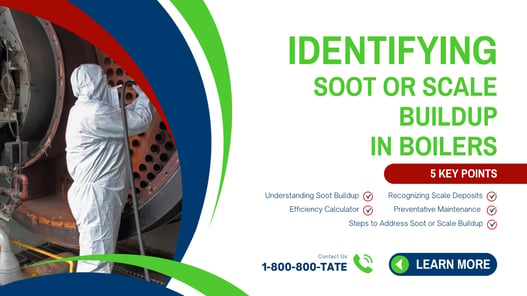
Boilers are an essential component of many industrial and commercial operations. However, they can become less efficient over time due to accumulating soot or scale. Identifying and addressing these issues promptly is crucial to maintaining optimal boiler performance. In this blog, we will explore the telltale signs and symptoms of soot or scale buildup in boilers and discuss the necessary steps to mitigate the problem effectively.
Understanding Soot Buildup
Soot is a black, carbonaceous substance that forms when fuel combustion is incomplete. It can accumulate on the internal surfaces of a boiler, hindering heat transfer and reducing overall efficiency. Here are some indicators of soot buildup.
- Increased Fuel Consumption: Soot buildup impedes heat transfer, forcing the boiler to work harder and consume more fuel to achieve the desired output.
- Higher Flue Gas Temperature: Soot acts as an insulating layer, leading to elevated flue gas temperatures. Monitoring flue gas temperatures can help detect soot accumulation.
- Black Smoke or Excessive Soot Deposits: Visibly black smoke or soot deposits on boiler components, such as burner nozzles or heat exchanger tubes, are clear signs of soot buildup.
Here is a resource that helps boiler users understand current operating costs and the impact changes can have on increasing production, reducing fuel, and overall operation costs. Utilize ABMA’s exclusive screening tool to reduce boiler operating costs and boost equipment longevity.
Recognizing Scale Deposits
Scale, also known as mineral deposits, is formed when dissolved minerals in water precipitate and accumulate on boiler surfaces. These deposits can restrict water flow and hinder heat transfer, causing various operational issues.
For Example:
- 1/16” Thick Scale buildup on tubes increases fuel consumption 15%
- 1/8” Thick Scale increases fuel consumption 20%
- 1/4” Thick Scale increases fuel consumption 39%
Here are some common indications of scale buildup:
- Decreased Water Flow: Scale deposits reduce the pipe's inner diameter, restricting water flow through the boiler system. If left unaddressed, this can lead to decreased heat transfer efficiency and even boiler failure.
- Uneven Heat Distribution: Scale formation on heat exchanger surfaces creates hotspots and uneven heat distribution, resulting in reduced performance and potential damage to the boiler.
- High Energy Consumption: Scale acts as an insulator, reducing heat transfer efficiency and forcing the boiler to consume more energy to maintain the desired temperature.
Related Article: Facility Contingency Planning
Steps to Address Soot or Scale Buildup
Identifying soot or scale buildup is only the first step; taking appropriate measures to address the issue is crucial. Here are some steps to mitigate soot or scale accumulation effectively:
- Regular maintenance and cleaning: Implement a routine maintenance schedule to clean the boiler and remove any accumulated soot or scale. This includes cleaning burner nozzles, heat exchanger surfaces, and other affected components.
- Water Treatment: Proper water treatment can prevent scale formation by reducing the mineral content in the boiler feedwater. Consult with a water treatment specialist, Tate Engineering, to determine the appropriate treatment method for your specific boiler system.
- Combustion Optimization: Optimize the combustion process to minimize soot formation. This may involve adjusting fuel-to-air ratios, ensuring proper burner operation, and conducting regular combustion efficiency tests.
- Monitoring and Inspection: Daily monitor flue gas temperatures, flame condition (thru site glass), water flow rates, and other relevant parameters to detect early signs of soot or scale buildup. Conduct thorough inspections to identify any potential problem areas.
Identifying and addressing soot or scale buildup is vital for maintaining the efficiency and longevity of boilers. By recognizing the signs and symptoms of these issues, implementing proper maintenance practices, and taking proactive steps to mitigate their impact, boiler operators can ensure optimal performance and prolong the lifespan of their equipment. Early detection and timely action are key to avoiding costly repairs and downtime caused by soot or scale accumulation.
Related Article: Boiler Maintenance Checklist Download
Tate Engineering - THE Experts in Preventative Maintenance
Scheduling a professional inspection, cleaning, and servicing the system and taking proactive measures to maintain its efficiency. Regular maintenance is essential to extend the life of the system and ensure its safety. Expert technicians can inspect the system, identify any potential problems, and provide the necessary repairs or maintenance. Regular inspections and cleanings can help to keep the system running smoothly and efficiently. Contact the boiler room pros at Tate Engineering Now!
